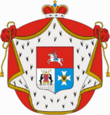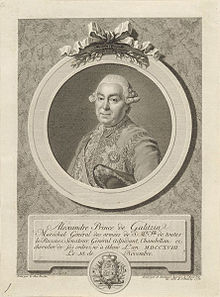House of Golitsyn
| Golitsyn Голицын | |
|---|---|
 | |
| Parent house | House of Gediminas |
| Country | Grand Duchy of Moscow Tsardom of Russia Imperial Russia |
| Founded | 15th century |
| Founder | Mikhail Bulgakov-Golitsa |
| Titles | Prince and Princess |
| Cadet branches | Kurakins , Khovansky , Koretsky |

The Golitsyn (Russian: Голи́цын, romanized: Golitsyn, IPA: [ɡɐˈlʲitsɨn]) family, one of the largest and most princely of the noble houses of Russia, originated in the Duchy of Lithuania.
Since the extinction of the Korecki family in the 17th century, the Golitsyns have claimed dynastic seniority in the House of Gediminas. Notable members include Vasily Vasilyevich Golitsyn (1643-1714), Boris Alexeyevich Golitsyn (1654-1714) and Dmitry Mikhaylovich Golitsyn (1665-1737).
Alternative transliterations of the name include: Golitsin, Golitsyne, Galitsin, Galitzin, Galitzine and Holytsin.
Origins
The family descends from a Lithuanian prince George, son of Patrikas and grandson of Narimantas. He immigrated to the court of Vasily I and married Vasily's sister. His children and grandchildren, Vassian Patrikeyev, were considered premier Russian boyars.
One of them, Prince [[{{{1}}}]] [], earned the nickname Golitsa (geležìs in Old Lithuanian) for an iron glove he wore in the Battle of Orsha in 1514. Bulgakov His son Yuri Bulgakov-Golytsin continued with the family line and his great-grandson Prince Vasily Golitsyn (+1619) was active during the Time of Troubles and went as an ambassador to Poland to offer the Russian crown to Prince Władysław.
Other notable Golitsyns


Vasily Vasilyevich Golitsyn (1643–1714), outstanding Russian statesman of the 17th century
Dmitry's brother Mikhail (c.1674–1730) was a celebrated heroic soldier, 'prince valiant', who is best known for his governorship of Finland (1714–1721), where his magnanimous rule was remembered as noble and exemplary by the people he had conquered as the Greater Wrath (Swedish: Stora ofreden). General field marshal.
His younger brother, another Mikhail Mikhailovich Golitsyn (1684–1764) was general admiral of the Russian fleet (1756).
And Mikhail's son Alexander Mikhailovich (1718–1783) was a diplomat and soldier, who likewise rose to be field-marshal and governor of St. Petersburg.
Another son of Mikhail's, Dmitry Mikhailovich (1721–1793), was the Russian ambassador in Vienna during the reign of Catherine the Great. Primarily remembered for the splendid Golitsyn Hospital he opened in Moscow, he should also be noted as a great friend and patron of Mozart.
Another Alexander Mikhailovich Golitsyn (1723–1804), son of general admiral Mikhail Mikhaylovich Golitsyn
Prince Dmitry Alekseyevich Golitsyn (1738–1803) was the Russian ambassador to the Netherlands and a Fellow of the Royal Society.
A son of Dmitry Alekseyevich, Prince Dmitry Dmitriyevich Golitsyn (1770–1840), also known as the Apostle of the Alleghenies, was the first Roman Catholic priest ordained in America; a settlement in Pennsylvania is named after him. He is currently under investigation for possible Sainthood, his current title is Servant of God.
Prince Dmitri Vladimirovich Golitsyn (1771–1844) fought bravely during the Napoleonic wars, was promoted to the rank of Lieutenant General and governed Moscow for 25 years.
Prince Alexander Nikolayevich Golitsyn (1773–1844) was a reactionary minister of education in the government of Alexander I. He headed an investigation into masonic involvement in the Decembrist uprising of 1825 and served as the Chairman of the State Council from 1838 to 1841.
Princess Yelizaveta Alexeyevich Golitsyna (1797-1844) Roman Catholic nun.
Prince Nikolay Borisovich Galitzin (1794–1866) was an amateur cellist who commissioned Beethoven to write his last string quartets, sometimes called the Galitzin quartets.
Prince Alexei Vasilyevich Golitsyn (1832–1901) was a friend of Pyotr Ilyich Tchaikovsky. Like the composer, Golitsyn was homosexual; but unlike the composer, he lived openly with his lover, Nikolay Vasilyevich Masalitinov (d. 1884).[1]
Prince Grigory Sergeyevich Golitsin (1838—1907) was a general and the Governor of Transcaucasia in 1897-1904.
Prince Lev Sergeyevich 24 June [O.S. 12 June] 1845–8 January 1916 [O.S. 26 December 1915] was one of the founders of winemaking in the Crimea. In his Crimean estate of Novyi Svet he built the first Russian factory of champagne wines. In 1889 the production of this winery won the Gold Medal at the Paris exhibition in the nomination for sparkling wines. He became the surveyor of imperial vineyards at Abrau-Dyurso in 1891.
Prince Boris Borisovich (1862–1916) was a prominent physicist who invented the first electromagnetic seismograph in 1906.
Prince Nikolai Dmitriyevich Golitsyn (1850–1925) was the last Tsarist prime minister of Russia, at the time of the February Revolution.
Sergei Golitsyn (1909–1989) wrote Memoirs of a Survivor: The Golitsyn Family in Stalin's Russia, a memoir of his experiences of the period from the start of the Revolution in 1917 to Russia's entry into World War II in 1941.
Prince Yuri Golitsyn Born Yokohama Japan 1919 One of the founders of public relations having written the handbook on the subject and pushed research on the family forward to being published in a book. He was also a member of The Right Society and yet championed action against concentration camps after being the first allied officer to witness one firsthand (Natzweiler)[2]
Princess Irene Galitzine (1916–2006), fashion designer
Prince Georgy Sergeyevich Golitsyn (born 1935), Russian physicist noted for his research on the concept of nuclear winter.

Prince Leo Golitsyn escaped from Soviet Russia during World War I and came to settle in Canada by 1929 in Edson, Alberta. He and his wife purchased 420 acres of land, one-quarter section from M. Silva and a half-section from Neil Armstrong. Most of the property bordered the McLeod River. Other than the 110 acres of farm land, they owned 5 pairs of foxes, poultry, horses and cattle.[3] Golitsyn, together with his wife, an Egyptian Princess, bought an airplane and started a charter company at Bear Lake. After the Princess died during a vacation to Europe, Leo moved to Hollywood where he was seen acting in various films as an extra. His most notable works are The Razor's Edge (1946 film) and The Chocolate Soldier.[4]
Prince George Golitzin (1916-1992) was the associate producer for Pollyanna and Parent Trap. Prince George's children are Alexander, John, Katherin and George. Bishop Alexander (Golitzin) (born 1948),[5] is Bishop of Toledo and the Bulgarian Diocese for the Orthodox Church in America and is presently locum tenens for the Diocese of Chicago and the Midwest. He is also emeritus professor of theology at Marquette University in Milwaukee, Wisconsin, USA. His academic work focuses on the discerning the roots of eastern Christian spirituality in Second Temple Judaism.[6] John Golitzin was an opera singer, now deceased. George Golitzin received his bachelor's degree in Mathematics from Harvard University and PhD in Mathematics from Yale university, specializing in Algebraic Number Theory. He presently holds the clerical rank of protodeacon and serves at St. Nicholas Church in San Anselmo, California.[7]
Prince Emanuel Vladimirovich Golitsyn (1918-2002), World War II Spitfire pilot.
Alexander Golitzen, (Moscow, 28 February 1908 – San Diego, 26 July 2005) oversaw art direction on more than 300 movies.
Notes
- ^ Alexander Poznansky, Tchaikovsky: The Quest for the Inner Man, many refs
- ^ http://foxleybooks.blogspot.com/p/research.html
- ^ Edson 75-Marguerite Ahlf
- ^ Edson 75-Marguerite Ahlf
- ^ [1]
- ^ http://www.marquette.edu/maqom/
- ^ http://oca.org/parishes/oca-we-saasnc
References
- Sjöström (2011), Liettuan gediminidien suomensukuiset geneettiset juuret. ISSN 1239-3487, Donelaitis - Donelaitis-seuran, Liettuan Ystävät ryn lehti 1/2011, ss 16..18
- Chisholm, Hugh, ed. (1911). "Gallitzin, Demetrius Augustine". Encyclopædia Britannica. Vol. 11 (11th ed.). Cambridge University Press. p. 421.
- Chisholm, Hugh, ed. (1911). "Golitsuin (various)". Encyclopædia Britannica. Vol. 12 (11th ed.). Cambridge University Press. pp. 225–226.
External links
- Marek, Miroslav. "Genealogy of the Golitsyn family". Genealogy.EU.
{{cite web}}: External link in|publisher= - Site of Princess Irene Golitsyn
- Golitsyn Museum in Moscow
